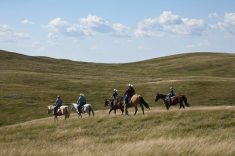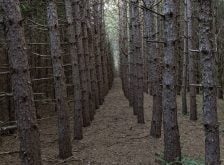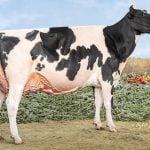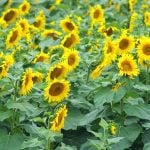What is hay? Recent hamburger commercials keep referring to grass-fed beef. If you feed your cattle hay, are they still grass fed? All the year round, grass feeding occurs in very few areas of the world. In most of North America, hay is fed up to six or seven months of the year. Bison or cattle feeding on a winter prairie seldom have enough natural grass to eat, let alone to gain significant weight. Does the brown or bleached Prairie sward in winter qualify as grass? Matter of fact, all the small grain cereals including corn are grasses. Does this qualify as grass fed? Does good silage qualify as grass fed? Does an alfalfa or clover mix qualify as grass fed? So much for advertising?
Growing hay for sale can be profitable and sustainable. It all depends on management and the target livestock that consumes the hay you produce.
I raised a small flock of up to 10 Shetland sheep for some 20 years at my acreage just west of Edmonton. They accomplished their primary jobs of removing trembling aspen suckers and regenerating willow stumps. I fed them hay from several farms in the area — all from the small square bales primarily intended for horses.
Read Also

How we combine stock and option strategies
Options can enhance an investor’s returns — but should only be considered after significant and successful experiences with stocks, including a vicious bear market, Herman VanGenderen writes.
One winter, I compared four small bales from four separate farm sources. The sheep graded the four bales very definitely. One bale from a progressive farmer in the Edmonton area they devoured right away. Of the other three bales, they eventually ate two of them and the last bale they barely ate at all.
If you are in the business of selling hay, it doesn’t take long for your customers to understand hay quality, whether it’s for horses, sheep, goats, llamas, cattle or other hay-consuming livestock.
Quality hay for horses
Canada has about a million horses from coast to coast with 50 per cent on the Prairies (Alberta has 33 per cent, Saskatchewan has 11 per cent and Manitoba has six per cent). British Columbia has 12 per cent of the horse population.
Half a million horses take a lot of feeding, considering most are pets or recreational animals, not including racehorses or working animals. Horses consume two to 2.5 per cent of their bodily weight in dry matter daily. Therefore, a 1,000-pound horse can be expected to consume 20 to 25 pounds of hay daily. Just about half of a typical small square bale. Bales can also vary in weight from 35 to 70 pounds.
Assuming the half a million horses on the Prairies are properly fed in the winter, they would require about 250,000 bales daily of hay, if this is the sole component of their diets for up to 250 feeding days per year. You can do the math. Of course, large horse operations would likely buy the big round or square bales from 500 pounds and up.
Horse owners prefer alfalfa hay mixed with either timothy, orchard grass or bromegrass, which would have around 10 to 12 per cent crude protein. Horses, unlike cattle, do not usually bloat on alfalfa, but too high of an alfalfa level would result in higher urea (nitrogen levels) in the urine. Orchard grass holds its colour and is less dusty than bromegrass.
Some of the hay bales cut from old, tired pastures or land devoid of legumes that have been “hayed” for dozens of years are poor feed indeed. I have seen an analysis of perpetually harvested hay pasture hay to be no better than plain wheat straw. Sell hay like this and you will soon lose any customers you have acquired.
Farmers on the Prairies, particularly those near urban areas, who would like to produce hay for the horse market and prosper from it must follow strict nutrition rules for the end product — quality hay.
Taking crops off your hay land is much the same as cropping it to wheat or canola. You must have adequate fertility inputs to produce a quality product. The more successful farmers catering to this annual hay market of 60 million small bales, must care for their hay crops. They generally seed a mixture of timothy or bromegrass along with alfalfa into cropland to end up with around 40 to 50 per cent alfalfa in the sward. The alfalfa is expected to produce some but not all of the crop’s nitrogen requirements, provided the soil pH is above six. Clovers are either too short or cause digestion problems or food refused in horse (i.e. bird’s-foot trefoil). In acidic or saline soils, pure grass hay may be the best option.
Nutrient removal by the quality of hay crop
Every ton of quality mixed grass/alfalfa hay land removes per acre the following nutrients (fertilizers), 30 to 35 pounds of nitrogen (N), 10 pounds of phosphate (P), 40 pounds of potash (K), five pounds of sulphur (S) as well as calcium, magnesium and micronutrients. So, calculate the cost of producing a ton of hay in fertilizer costs.
If you take off four tons per acre of hay, perhaps in two cuts in some years, then you can see the amount of nutrients that have been removed — 120 pounds of nitrogen, 40 pounds of phosphate, 160 pounds of potash and 20 pounds of sulphur. Just make a note of the amount of potash needed for the four tons of hay.
To maintain this rate of nutrient removal, you may apply up to 60 pounds of nitrogen, assuming that your 40 per cent alfalfa fixes up to 60 pounds, and all the other nutrients annually based on the tonnage of hay removed from your cropland. No ifs, ands, or buts about it. What you take out you must replace or your hay crop will drop in yield and quality very quickly. The hay price should reflect the current cost of fertilizer as well as all other farm harvest inputs.
Such hay land can be kept for five to six years and used, perhaps, as a long-term rotation if your cropland is badly infested with clubroot of canola or aphanomyces of peas.
Remember, horse owners are picky and usually well off, so be sure to produce bales of hay free of dust or mould and is fresh smelling. They will pay for quality.
Timothy hay producers, either dryland or under irrigation in the southern Prairies, are producing a crop primarily for the export market. This timothy hay is small square bales, and the bales are compressed to maybe a third of their size for space convenience. This quality hay produced under contract is usually bound for countries like Japan that need this hay for roughage feed primarily for both dairy and beef cattle.
















